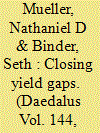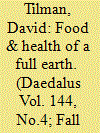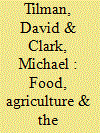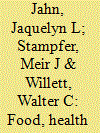|
|
|
Sort Order |
|
|
|
Items / Page
|
|
|
|
|
|
|
| Srl | Item |
| 1 |
ID:
141260


|
|
|
|
|
| Summary/Abstract |
The social, economic, and environmental costs of feeding a burgeoning and increasingly affluent human population will depend, in part, on how we increase crop production on under-yielding agricultural landscapes, and by how much. Such areas have a “yield gap” between the crop yields they achieve and the crop yields that could be achieved under more intensive management. Crop yield gaps have received increased attention in recent years due to concerns over land scarcity, stagnating crop yield trends in some important agricultural areas, and large projected increases in food demand. Recent analyses of global data sets and results from field trials have improved our understanding of where yield gaps exist and their potential contribution to increasing the food supply. Achieving yield gap closure is a complex task: while agronomic approaches to closing yield gaps are generally well-known, a variety of social, political, and economic factors allow them to persist. The degree to which closing yield gaps will lead to greater food security and environmental benefits remains unclear, and will be strongly influenced by the particular strategies adopted.
|
|
|
|
|
|
|
|
|
|
|
|
|
|
|
|
| 2 |
ID:
141263


|
|
|
|
|
| Summary/Abstract |
As the collective impact of human activity approaches Earth's biophysical limits, the ethics of food become increasingly important. Hundreds of millions of people remain undernourished, yet only 60 percent of the global harvest is consumed by humans, while 35 percent is fed to livestock and 5 percent is used for biofuels and other industrial products. This essay considers the ethics of such use of edible nutrition for feedstock and biofuel. How humanity uses Earth's land is a reflection of its values. The current land-use arrangements, which divert 40 percent of all food to feed animals or create fuels, suggest that dietary and transportation preferences of wealthier individuals are considered more important than feeding undernourished people, or the stability of the wider biotic community.
|
|
|
|
|
|
|
|
|
|
|
|
|
|
|
|
| 3 |
ID:
141256


|
|
|
| 4 |
ID:
141257


|
|
|
|
|
| Summary/Abstract |
Secure and nutritious food supplies are the foundation of human health and development, and of stable societies. Yet food production also poses significant threats to the environment through greenhouse gas emissions, pollution from fertilizers and pesticides, and the loss of biodiversity and ecosystem services from the conversion of vast amounts of natural ecosystems into croplands and pastures. Global agricultural production is on a trajectory to double by 2050 because of both increases in the global population and the dietary changes associated with growing incomes. Here we examine the environmental problems that would result from these dietary shifts toward greater meat and calorie consumption and from the increase in agricultural production needed to provide this food. Several solutions, all of which are possible with current knowledge and technology, could substantially reduce agriculture's environmental impacts on greenhouse gas emissions, land clearing, and threats to biodiversity. In particular, the adoption of healthier diets and investment in increasing crop yields in developing nations would greatly reduce the environmental impacts of agriculture, lead to greater global health, and provide a path toward a secure and nutritious food supply for developing nations.
|
|
|
|
|
|
|
|
|
|
|
|
|
|
|
|
| 5 |
ID:
141259


|
|
|
|
|
| Summary/Abstract |
The dual burden of obesity and undernutrition is a significant public health challenge worldwide, especially in the context of a changing climate. This essay presents the most recent nutritional evidence for the optimal diet for long-term health, and offers some commentary on how production of these foods affects the environment. Current dietary research supports a diet rich in fruits and vegetables; nuts, legumes, fish, and some poultry as protein sources; unsaturated fats replacing saturated fats; whole grains replacing refined grain products; dairy foods in low to modest amounts; and minimal amounts of red meat and added sugar. This healthy dietary pattern also supports sustainable agriculture and environmental preservation.
|
|
|
|
|
|
|
|
|
|
|
|
|
|
|
|
| 6 |
ID:
141258


|
|
|
|
|
| Summary/Abstract |
Women are ubiquitous and critical to the nutritional well-being of their families, yet they are often invisible to policy-makers, public officials, community leaders, and researchers. Effecting significant decreases in the number of hungry poor people, as well as the improvement of nutritional and economic outcomes, requires policy in addition to operational and research priorities that are directed at the needs of women and girls.
|
|
|
|
|
|
|
|
|
|
|
|
|
|
|
|
| 7 |
ID:
141261


|
|
|
|
|
| Summary/Abstract |
Opinions on how to limit the immense impact of agriculture on wild species are divided. Some think it best to retain as much wildlife as possible on farms, even at the cost of lowering yield (production per unit area). Others advocate the opposite: increasing yield so as to limit the area needed for farming, and then retaining larger areas under natural habitats. Still others support a mixture of the two extremes, or an intermediate approach. Here we summarize a model designed to resolve this disagreement, and review the empirical evidence available to date. We conclude that this evidence largely supports the second, so-called land-sparing approach to reconciling agriculture and biodiversity conservation, but that important questions remain over the generality of these findings for different biota and for ecosystem services, how best to increase yields while limiting environmental externalities, and whether there are effective, socially just, and practical mechanisms for coupling yield growth to habitat retention and restoration.
|
|
|
|
|
|
|
|
|
|
|
|
|
|
|
|
| 8 |
ID:
141262


|
|
|
|
|
| Summary/Abstract |
The defining challenge of sustainable agriculture is the production of food and other agricultural products at an environmental cost that does not jeopardize the food security and general welfare of future generations. Feeding another three billion people in the face of climate change, biodiversity loss, and an environment already saturated with excess nitrogen and other reactive pollutants requires new approaches and new tools in the design and deployment of workable solutions. Solutions will be local but all will require an ecological systems approach that considers sustainable farming practices in the full context of ecosystems and landscapes. And their deployment will require an understanding of the social systems capable of building incentives that produce socially desired outcomes. Socioecological models for agriculture provide an opportunity to explore feedbacks, trade-offs, and synergies that can optimize and strengthen emerging connections between farming and society. With the right incentives, innovative research, and political will, a sustainable agriculture is within our reach.
|
|
|
|
|
|
|
|
|
|
|
|
|
|
|
|
|
|
|
|
|